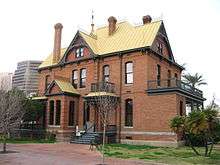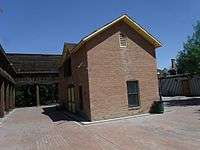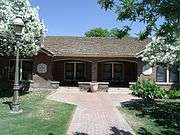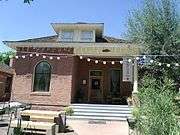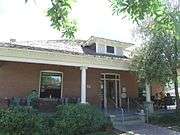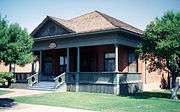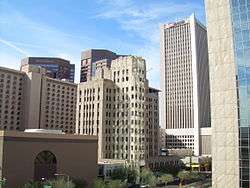Downtown Phoenix

Downtown Phoenix is the central business district (CBD) of the City of Phoenix, Arizona, United States. It is located in the heart of the Phoenix metropolitan area or Valley of the Sun. Phoenix, being the county seat of Maricopa County and the capital of Arizona, serves as the center of politics, justice and government on the local, state and federal levels. The area is a major center of employment for the region, with many financial, legal, and other national and international corporations housed in a variety of skyscrapers. Major arts and cultural institutions also call the area home. Downtown Phoenix is a center of major league sports activities, live concert events, and is an equally prominent center of banking and finance in Arizona. Regional headquarters for several major banks, including JP Morgan Chase, Wells Fargo, US Bank, Bank of America, Compass Bank and Midfirst Bank are all located within or close proximity to the area.
The City of Phoenix defines Downtown as the area between 7th Street and 7th Avenue, from McDowell Road on the north to Buckeye Road on the south.[1] However, the majority of downtown development is concentrated in the smaller area surrounding the intersection of Washington St. and Central Ave (which is the point of origin of Phoenix street addresses and numbering). Downtown Phoenix is one of a few major business districts in the city; others include Midtown Phoenix to the north, and the Biltmore District four miles northeast of downtown.
History
Territorial era
In 1870, a meeting was held to select a town site for the influx of pioneers coming to the recently recognized town of Phoenix. 320 acres were purchased for $50 raised by popular subscription. This original site, the whole of the town of Phoenix in that day, encompasses what would presently be the Downtown Core, bordered by Van Buren Street south to Jackson Street, and Seventh Street to Seventh Avenue.[2]
With the first survey of the new town, streets were laid out in a grid, with Washington Street as the main east-west thoroughfare. The north-south streets originally bore Native American tribal names, but were changed to more easily remembered numbers, with everything east of Center Street (later Central Avenue) named as streets and everything west as avenues. The town continued to grow, and was eventually incorporated as a city on February 28, 1881 centered around downtown.[3]
Throughout the 1880s the newly incorporated city made many strides toward modernization with the construction of one of the first electric plants in the West as well as the opening of the horse-drawn streetcar line. The Phoenix Street Railway system was eventually electrified and expanded to several different lines that connected Downtown Phoenix to other neighborhoods and cities in the Valley. Independence Day of 1887 heralded the arrival first Southern Pacific train. This opened up the economy of the young city, as goods now flowed in and out by train as opposed to wagon. As Phoenix became the center of commerce in the territory, the capital was moved to Phoenix, with temporary offices being set up in Downtown.[4]
Redevelopment
As Phoenix began to recover from the Great Recession, interest in re-energizing the urban core skyrocketed. In contrast to the pre-recession construction boom in the Phoenix area which primarily focused on the construction of low density communities and suburban office complexes, the most recent boom has been heavily focused on Central Phoenix, with the construction of higher density development, and a renewed interest in local business, bioscience, education, and the arts. Spurred by Arizona State University’s quickly developing Downtown Campus and a new Convention Center, Downtown Phoenix has quickly transformed into an attractive place for businesses. Areas such as Lower Grand, Roosevelt, and the Warehouse District have seen a massive investment in art, adaptive reuse, and local restaurants.[5]
In February 2015, the Super Bowl was held in Arizona and, unlike the 2008 Super Bowl, many of the major NFL events were held on the streets of Downtown Phoenix, showcasing to the world how the city had transformed its downtown into a lively, thriving community full of creative energy and opportunity. The construction of Phoenix’s light rail system as stemmed major development projects in Downtown Phoenix along the Central Avenue corridor. A new arena for the Phoenix Suns and Arizona Coyotes is also in the works, along with the renovation of the Professional Building into a boutique hotel, the addition of nearly 25,000 apartments, and two more new hotels at Collier Center and Luhr’s Center.[6]
Attractions
Downtown Phoenix has many points of interest including museums, sports venues, performing arts venues and a thriving art scene.
Museums
Downtown's cultural attractions include the Arizona Science Center, Phoenix Museum of History, the Phoenix Art Museum, the Rosson House and the Burton Barr Central Library.
Sports
Downtown Phoenix has a large sports presence. Chase Field is home to the Arizona Diamondbacks. It was the site of the Insight Bowl from 2001 to 2005 and hosted the 2006 World Baseball Classic and international soccer games.
Talking Stick Resort Arena is home to the Phoenix Suns, Phoenix Mercury and Arizona Rattlers. The ECHL's Phoenix RoadRunners played there from 2005 to 2009. It hosted the NBA All-Star game on February 15, 2009.
Performing arts
Phoenix Symphony Hall is home to the Phoenix Symphony. The Tucson-based Arizona Opera has staged many of its productions in Phoenix at Symphony Hall. Ballet Arizona also stages many of its productions at Symphony Hall.
Orpheum Theater originally built as a grand movie house in 1927, had undergone a 12-year, $14 million extensive renovation ending in 2002. The theater now stages everything from beauty pageants to Broadway shows.
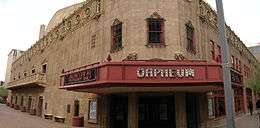
The Herberger Theater Center was built in 1989, has three stages and is home to 3 resident companies: Actors Theater, Arizona Theater Company and Center Dance Ensemble.
The Comerica Theatre, a Live Nation venue, is a state of the art entertainment venue designed specifically for concerts, Broadway shows, family stage shows, and boxing. Originally known as Dodge Theatre before the primary sponsorship changed in 2010, the facility seats up to 5,000 people.

Architecture
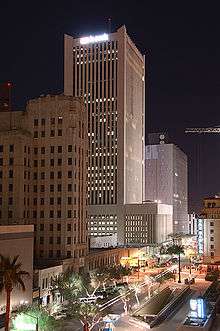
About twenty-five mid-rise and high-rise buildings ranging up to 40 stories tall pierce the skyline. Three of the five tallest skyscrapers in the state of Arizona are in Downtown Phoenix. Chase Tower, at 40 stories and a height of 483 feet (147 m), is the tallest. U.S. Bank Center's 31 floors and 407 feet (124 m) tall is number two. 44 Monroe, at 34 floors and a height of 380 feet (120 m) is Phoenix’s 4th tallest. One Central Park East tops out at 26 floors and is 116.7 meters (382 ft) tall.
The architecture of Downtown offers many examples of 20th-century architectural styles including the Beaux Arts-style Security Building and Hotel San Carlos. Art Deco design can be seen in Luhrs Tower, Hotel Monroe (formerly the Professional Building) and the Orpheum Lofts. International Style was popular from the 1960s to the 1980s and prime examples include Chase Tower and U.S. Bank Center. The short-lived brutalist style has only one example in downtown Phoenix in the Wells Fargo Plaza. Post modern, with its return to architectural ornamentation, can be seen in the Bank of America Tower, both towers at the Arizona Center and, most notably, in the crown of the Phoenix City Hall Building.
The recent trend of urban living has led to the conversion of the 1930s-era Phoenix Title and Trust building to condominiums called Orpheum Lofts; as well as the newly built residential towers 44 Monroe and The Summit at Copper Square, with many more in the planning stages. Taylor Place, two 13-story towers which serve as the new residential community of the Downtown campus of Arizona State University, opened in August 2008. Alta Phoenix Lofts, a multi-level, 332-unit apartment project, is rising north of the Arizona Center.
Historic Heritage Square
| Wikimedia Commons has media related to Heritage Square, Phoenix. |
Historic Heritage Square is part of Heritage and Science Park on the east end of downtown. It encompasses the only remaining group of residential structures from the original town site of Phoenix.
The Lath House Pavilion, although completed in 1980, its design is heavily influenced by combining 19th Century concepts of a botanical conservatory, a gazebo, a beer garden and a pedestrian shopping arcade, all of which were common features of early Phoenix architecture. The Pavilion hosts many national and cultural festivals throughout the year.
The Rosson House is the cornerstone of a city block dating from the late 19th century. The house has been restored to its Victorian roots and offers tours.
The Duplex, built in 1923, is the youngest of the homes on the block. Its sleeping porches constructed with canvas and wood panels, let in the cool evening desert air.
The Carriage House is located in the center of the Square. It was built as a mule barn for the Teeter House in 1899.
The Silva House, a bungalow with neoclassical revival influences, was built in 1900. The Rose and Crown, an English Pub now occupies this historical home.
The Bouvier-Teeter House was built in 1899. It is now a Victorian Tea Room.
The Baird Machine Shop was a commercial structure when it was built in 1929. It is now home to Pizzeria Bianco, which has been named by various sources as the best Pizza in America.[7]
The Thomas House was moved to block 15, of Historic Heritage Square in the 1980s to save the home from demolition. This 1909 neoclassical styled building houses Bar Bianco, an adjunct to Pizzeria Bianco.
The Stevens- Haugsten House was built in 1901 as a rental property. The building is significant for its representation of the historic California bungalow style built around the turn of the 20th century.
The Stevens House, built in 1901 with obvious midwestern influences, now houses The Arizona Doll & Toy Museum.
| Phoenix's Historic Heritage Square | ||||||||||||||||||||
|---|---|---|---|---|---|---|---|---|---|---|---|---|---|---|---|---|---|---|---|---|
|
Roosevelt Row
Roosevelt Street is an east-west corridor that runs through the northern edge of Downtown. Roosevelt Row, roughly bounded by 7th Avenue to 16th Street,[8] has reinvented itself from a blighted, drug infested area to the epicenter of the Central Phoenix art scene. This neighborhood has become home to artist live/work spaces, gallery spaces and studio spaces. It has been described as "a dynamic, walkable urban mixed-use area with a significant concentration of artists and other creative professionals."[9] Since 1994 the monthly First Fridays artwalk has grown to become the largest monthly artwalk in the United States. Increasing interest in this area has prompted Roosevelt Row to becoming more pedestrian-friendly and is supportive of small local independent businesses that give downtown Phoenix character. The area's development is overseen by the non-profit Roosevelt Row Community Development Corporation.
Historic neighborhoods
Downtown and Central Phoenix are home to several historic neighborhoods ranging from turn-of-the-20th-century Victorian to mid-20th-century modern architecture. Some of them, like the Willo and Encanto-Palmcroft districts, are more established and in demand, while others are still redeveloping. The better-known districts include Coronado, Roosevelt, Encanto-Palmcroft, FQ Story, North Encanto, Willo, and Woodlea.
Encanto-Palmcroft Historic District
Rooted firmly in the City Beautiful movement of planning, the Palmcroft and Encanto Districts were developed starting in the late 1920s. With winding lanes, tree-lined streets, lush landscaping and nearby Encanto Park, this neighborhood resembles more of an English suburb than a Phoenician neighborhood. The district contains many larger, period revival manors, marking a time when it was a getaway from the hustle and bustle of early city life.
Roosevelt Historic Neighborhood
Honored with the first distinction of historical designation in the City of Phoenix, the Roosevelt Neighborhood has a history that is rich and deep. From its architectural milestones still visible today, its importance in Phoenix’s original booming tourist trade, and its role as one of the first “streetcar suburbs,” Roosevelt has remained a vital community to the city’s past, present, and future. It lies bounded by Central Avenue and 7th Avenue from McDowell to Fillmore and is peppered with buildings and homes of architectural significance. It is a true urban neighborhood, with a walkable scale, close proximity to public transportation, and friendly neighborhood cafes and local businesses.
Government and infrastructure
The United States Postal Service operates the Downtown Phoenix Post Office at 522 North Central Avenue.[10]
Downtown Phoenix in film and television
Mel's Diner, on the outskirts of downtown has been an old Phoenix landmark for decades. It is famous for being the setting for the TV sitcom Alice.
Many movies have been filmed in Phoenix using downtown locations.
- The 1960 film, Psycho features the Downtown Phoenix skyline in the opening shot. Originally Alfred Hitchcock wanted a helicopter shot to fly through downtown into the window of a hotel, but the shot was changed to a series of pan and fade shots.
- In the 1998 remake of Psycho Gus Van Sant filmed the opening shot using a helicopter and zooming into the 8th floor of the Westward Ho.
- Parade scenes for the 1956 Marilyn Monroe film, Bus Stop, were filmed in front of the Westward Ho.
- In the film Waiting to Exhale, Lela Rochon is shown in front of the Phoenix City Hall building in her character’s introduction scene.
- In the film The Gauntlet, the open shots feature the Phoenix skyline. Downtown is also used in the final climatic shoot-out between Clint Eastwood's character and the Phoenix Police, ending in front of the Phoenix Symphony Hall.
- In the film Ninja III: The Domination, a car chase uses the streets of downtown.
- Blue Collar Comedy Tour: The Movie was filmed at The Dodge Theater in 2003.
- In the 1978 made-for-TV movie A Fire in the Sky, a comet crashes into Earth west of the city which destroys downtown Phoenix. Many landmarks are shown during the destruction. Wells Fargo Plaza and the Hyatt Regency Phoenix are shown collapsing while the glass skin of the Chase Tower, is blown from its steel skeleton. The antenna of the Westward Ho falls to the ground as a result of the impact blast. This film should not be confused for the 1993 alien abduction movie of the same name.
- In The Banger Sisters, the skyline is featured.
- In the film The Getaway, Phoenix stands in for Albuquerque with Kim Basinger navigating through downtown’s streets and alleys.
- The Arizona Center is used in the opening scenes of the 1998 film, Phoenix.
- The Paul Newman film, Pocket Money, used the Westward Ho courtyard for scenes in 1972.
- Olympic gold medalist Mitch Gaylord was filmed in the final competition scenes for 1986’s American Anthem at the now-razed Phoenix Union High School gym.
- In October 2008, Luke Wilson shot scenes throughout downtown for Middlemen.
Gallery
See also
References
- ↑ Urban Form Downtown Project City of Phoenix
- ↑ http://phoenix.gov/CITYGOV/history.html
- ↑ Barney, James M.; Goldwater, Barry M.; Williams, Jack (1951). "Incorporation in 1881". Out of the Ashes: The History of the City of Phoenix. City of Phoenix. Retrieved 28 July 2011.
- ↑ Barney, James M.; Goldwater, Barry M.; Williams, Jack (1951). "The Bustling 1890s". Out of the Ashes: The History of the City of Phoenix. City of Phoenix. Retrieved 8 August 2011.
- ↑ http://downtownphoenixjournal.com/2015/04/14/building-a-vision-for-downtown-phoenix-living/
- ↑ http://forum.skyscraperpage.com/showthread.php?t=173764
- ↑ Ed Levine (2004-07-07). "The Road to Pizza Nirvana Goes Through Phoenix". New York Times.
- ↑ http://www.rooseveltrow.org/about/
- ↑ http://www.rooseveltrow.org/about.html
- ↑ "Post Office Location - PHOENIX DOWNTOWN." United States Postal Service. Retrieved on April 17, 2009.
External links
| Wikivoyage has a travel guide for Downtown Phoenix. |
- Video celebrating Phoenix Architecture on YouTube
- Phoenix Museum of History
- Downtown Phoenix formerly Copper Square - Downtown Phoenix Partnership
- Phoenix Convention Center
- Art Link
- Copper Square news regarding Phoenix Convention Center
- Roosevelt Row
Live in Roosevelt Row:
